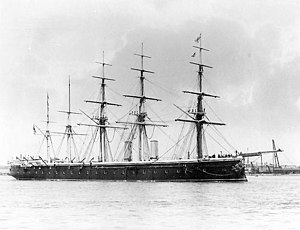HMS Minotaur (1863)

Minotaur at anchor
|
|
| History | |
|---|---|
|
|
|
| Name: | HMS Minotaur |
| Namesake: | Minotaur |
| Ordered: | 2 September 1861 |
| Builder: | Thames Ironworks and Shipbuilding Company |
| Laid down: | 12 September 1861 |
| Launched: | 12 December 1863 |
| Completed: | 1 June 1867 |
| Commissioned: | April 1867 |
| Fate: | Sold for scrap, 1922 |
| General characteristics (as completed) | |
| Class and type: | Minotaur-class armoured frigate |
| Displacement: | 10,627 long tons (10,798 t) |
| Length: |
|
| Beam: | 59 ft 6 in (18.1 m) |
| Draught: | 27 ft 9 in (8.5 m) |
| Installed power: | 6,949 ihp (5,182 kW) |
| Propulsion: |
|
| Sail plan: | 5-masted |
| Speed: | 14 knots (26 km/h; 16 mph) |
| Range: | 1,500 nmi (2,800 km; 1,700 mi) at 7.5 kn (13.9 km/h; 8.6 mph) |
| Complement: | 800 actual |
| Armament: | |
| Armour: | |
HMS Minotaur was the lead ship of the Minotaur-class armoured frigates built for the Royal Navy during the 1860s. They were the longest single-screw warships ever built.Minotaur took nearly four years between her launching and commissioning because she was used for evaluations of her armament and different sailing rigs. The ship spent the bulk of her active career as flagship of the Channel Squadron, including during Queen Victoria's Golden Jubilee Fleet Review in 1887. She became a training ship in 1893 and was then hulked in 1905 when she became part of the training school at Harwich. Minotaur was renamed several times before being sold for scrap in 1922 and broken up the following year.
The Minotaur-class armoured frigates were essentially enlarged versions of the ironclad HMS Achilles with heavier armament, armour, and more powerful engines. They retained the broadside ironclad layout of their predecessor, but their sides were fully armoured to protect the 50 guns they were designed to carry. Each was equipped with a plough-shaped ram that was also more prominent than that of Achilles.
The Minotaur-class ships were 400 feet (121.9 m) long between perpendiculars and 411 feet (125.3 m) long overall. They had a beam of 58 feet 6 inches (17.8 m) and a draft of 26 feet 10 inches (8.2 m). The ships displaced 10,627 long tons (10,798 t). The hull was subdivided by 15 watertight transverse bulkheads and had a double bottom underneath the engine and boiler rooms.
...
Wikipedia
